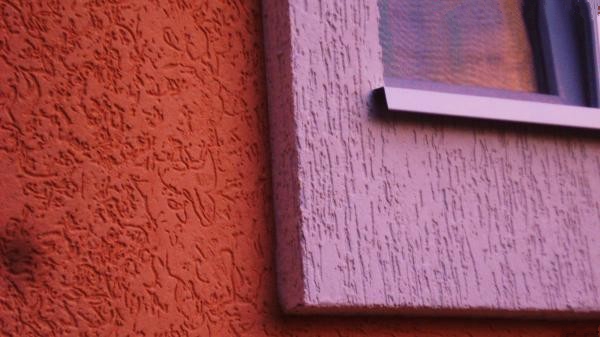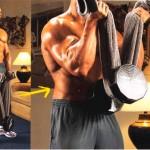A modern facade solution must solve several problems: protect the walls of the building from various destructive factors environment, to give the façade a dignified appearance from an aesthetic point of view and to strengthen it. All these abilities are possessed by modern facade plasters.
Facade plastering
In order to apply facade plaster to the walls, you will need very little: a ruler, a plumb line, a roller to create texture and the plaster itself.
But before proceeding with the main thing, you first need to properly prepare the surface of the walls for finishing work. First, you need to complete all construction or renovation work... Waterproofing, thermal insulation, roofing and framing for various architectural elements buildings must be fully prepared. In addition, it is imperative to clean the wall surface from mortar residues, paint and other possible contamination.
What instead of smooth plaster on the facade
Decorative grilles on the grille An excellent effect can be obtained by combining wood with plaster on the façade. Well suited for walls with wool and polystyrene, but recommended for areas with little air pollution because they are difficult to clean. They are ideal when the house is located in a forest or lakes, as well as on walls with high vapor permeability.
Trendy gray roofs: roofs, sheets or tiles?
Or renovation, plastering of plaster is required on the prepared facade, as a rule, it consists of two layers of finishing paint. However, always follow the manufacturer's instructions. Every week latest news about construction. Colors can even numb the wind. The gray roof also affects the facade. Light and cool shades of the facade will give the impression of a "clean" home. Bring it to life and keep it warm by pairing it with wood or plasters even in intense colors.
The next step is preliminary alignment of the walls. Their curvature should not exceed one and a half centimeters for every two meters. Determining the curvature of a wall is very simple. To do this, a flat bar is applied to the wall and the depth of the depressions is measured with a ruler. If they exceed the recommended values, the walls are pre-leveled with cement-sand mortar or a special leveling mixture, which can be purchased in a building supermarket in the form of a ready-made mixture.
Immediately before application facade plaster, you also need to check the degree of moisture in the walls. You can check whether the surface needs additional moistening in the following way: moisten a small fragment of the wall with a sponge and observe how quickly the moisture is absorbed into the wall surface.
New warming in an old house
However, warming is not possible if it does not require reinforcement of old layers. New home insulation on old insulation Insulation insulation, that is, installing a new home heating system on an existing one, is not easy, but it has another advantage: you do not have to pay.
The mosaic is waterproof and resistant to damage. Contains a fine-grained aggregate with grains from 0.8 to 3 mm. Apply it by hand using a metal spatula. You cannot finish walls covered with thermal stucco or plastic parts. Mosaic cost for 1 m2.
Application of facade decorative plaster
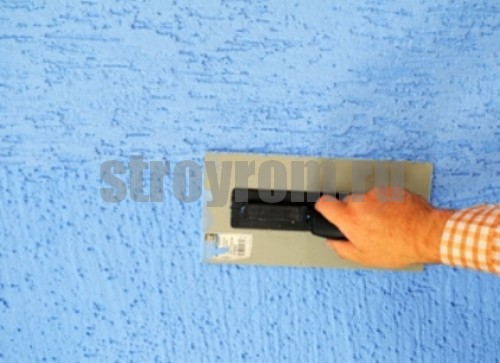
Facade plaster can be applied to walls different ways and a different tool depending on the skills available, the type of specific plaster mix and personal preference, you can use paint spatulas, wide brushes, rollers or any other suitable tool. It is also sometimes rational to apply facade plaster using mechanized means. This is especially beneficial when a fairly large area needs to be trimmed. This reduces the consumption of plaster and significantly saves time for work.
Of course, decorative plaster is applied to walls in a different way than traditional plaster. As a rule, it is given a special structure that significantly improves the aesthetic qualities of the final coating. But you should decide on the method of application at a very early stage in order to properly prepare - if necessary, prepare the surface of the walls and purchase the appropriate tool.
So, for example, in order to give the walls a pattern in the form of a scythe, a needle-like surface or to make the so-called bark beetle, a base layer of facade plaster is first applied to the wall using a trowel. Then, when the first layer dries up a little, the next one is applied on top of it. The second layer is processed with a special structured roller, which is made of rubber. It is with his help that the craftsmen achieve the above-mentioned structural drawings on the facade of buildings.
Wall renovation - keep it well
You must prime using the wet-on-wet method, that is, after the surface has been primed, even when wet, apply the next coat. This method promotes deep penetration of the primer into the substrate. Old floors, such as dirty mineral plaster, are usually required.
They built a new home, but they didn't want to give up the traditional elements.
Applied technical solutions, as well as the choice of materials. However, the owners also recommended that the layout of the interior be traditional. One of them is the tiled stove, which is not only functional, but also contributes to the integration of the whole family.
We build and repair ourselves
Modular block containers
Block containers are a very interesting element in many respects, used in the construction of objects of various purposes. Each block container is ...
How to make a ladder
Many owners of country houses are interested in a very important and serious question: how to make a good staircase with minimal costs so that it will last a long time and with high quality ...
Ceramic hollows: single and multi-layer walls
Authorized to take charge, the heat takes care of the proper heat transfer coefficient, and the brick clinker facade protects against external factors and gives appearance all kind. The wall is marked with a width of approximately 17.5 cm to 30 cm - depending on.
Therefore, on the narrowest elevations, the front and garden, the largest openings were located. This will give the interior a relatively broad perspective. A terrace was planned along the entire garden facade. It is best to keep as much space as possible around the appliance.
Maintaining the foundation of the house in excellent condition has the most positive effect on the condition of the building structures. The effectiveness of insulation, high-quality thermal insulation, and the correct operation of all communications depend on this. One of the most durable exterior coatings is considered a natural stone and decorative plaster, with the help of which you can qualitatively plaster the facade, giving it an attractive look.
What to build a house: double-layer walls
As a result, the facade looks aesthetically pleasing and the home is warm.
How to connect building materials correctly
The architectural advantage noted by the architects is the almost unlimited form of the façade. It is also often used on the entire surface of the wall, as well as in other materials such as plaster, stone, wood. Using bricks as a decorative piece helps bring out the different.Apply directly to the walls, provided that the plastered surfaces are prepared in the same way as in the thermal insulation system, that is, an adhesive solution with a reinforced reinforced mesh. Thin layer plaster can sometimes be applied over traditional plaster.
Practical material has a lot of varieties, advantages, in addition, all work on plastering walls is considered quite simple. This process belongs to the middle price category, but at the same time has excellent fire resistance and waterproof properties.
Plastering is necessary to create an attractive appearance of an architectural object and at the same time to protect the ventilated facade of the building from aggressive environmental influences.
Insulation without welds - a guide to preventing mistakes
Scratches, it is recommended to use a center where the color matches the color of the facade. The plaster is applied to a metal float and then immediately discarded using a rigid plastic plate. It is important to have sufficient personnel on the scaffold and handle.
It is neither expensive nor difficult as it was a few years ago. Most of the energy efficient brick houses nowadays are plank-mounted. This allows you to cover the structure with thermal insulation from all sides and, thus, protect the house from heat loss to the ground.
Decorative plaster for the facade of the house has many advantages:
- resistance to sudden changes in temperature;
- moisture resistance;
- strength and reliability;
- vapor permeability;
- improves noise and thermal insulation of the building;
- allows you to create a unique design;
- ease of application of the solution;
- low cost.
The cost of the finishing material largely depends on the quality of the ingredients that are included in the mixture.
The most popular house for wall insulation
Investors usually understand that what they have on the facade is not just plaster and heating, but a whole system of additional components. If this was not enough, then it would be difficult for manufacturers to determine the situation, systematically changing the name of the thermal system to more and more.
Wall Insulation - Reinforcement Layer, Tips
For example, scaffolding anchors, fasteners, flashing through the heating system. The mortar should be applied to a mesh width thermal insulation tape. Typically, vertical stripes are usually upside down unless otherwise noted.
Warming house walls - with decorations
The same as for making cornices: applying mortar, melting into a reinforcing mesh and plaster. When applying the plaster, it is important to keep in mind that the grooves between the grout should be smooth - this will make it difficult for dirt to accumulate. For facade repair Facade repair.
Insulation plaster facades have certain disadvantages. If the technology is not followed, some problems may arise:
- vertical or horizontal cracks;
- spotting of the material;
- swelling of the surface;
- peeling of the finish layer.
If cheap material was used, then after a few years it will be necessary to repair the plaster of the facade.
Testing drugs to remove the green raid
Smoke cleaning of the facade because you need permission to renovate the building supervision use silicone gate drives work cargo ceiling chimney cleaning balcony insulation insulation chimney insulation attic foam insulation floor insulation.
Outside the eaves in three ways
Formwork, eaves reinforcement and roof ceiling joining. Then everything is mixed with the concrete mix and leaves it alone.Facade painting - walls and roof in new colors
He must be strong, compact; You need to prepare them or the paint won't adhere well. Removal requires plaster and old paint. Only on this prepared facade there are usually two layers of finishing paint. The lower parts of buildings are caused by level or vertical insulation problems and by moisture and mineral salts. In general, the sooner you decide to renovate the destroyed façade, the less.
Sequence of works for plastering the facade
Facade decorative plaster is a relatively uncomplicated type of construction work. If you have certain knowledge and skills, it is quite possible to plaster the facade with your own hands. For the successful implementation of the upcoming activities, you must strictly adhere to the established scheme.
The width is greater than or equal to the width of the cassette. Oval boxes are also available for facade installation. They are characterized by increased strength and durability. This system is designed for atypical architectural solutions also used in historical buildings, but.
Horizontal and vertical application of "bark beetle"
Confirmed Research - The most popular time is traditional brick technology. Just as we are attached to it, we are so grateful for the material that has been known for years. Online forums, industry portals and construction magazines are common.
Surface preparation
Before plastering the facade, it is freed from various contaminants. Notches are stuffed onto the cleaned surface, this will ensure in the future a strong adhesion of the mortar to the plane of the wall. If plastering is carried out on a brick or stone wall, then the seams need to be deepened a little.
Widespread use of cement fiber. These are not only houses, but also public buildings. And it mostly has to do with roofing, it works great on facades. How to Create Fiberglass The secret to the high strength of fiber cement. It is highly resistant to scratches and damage. They also provide good warmth- and sound insulation, and their smooth, smooth and cohesive surface facilitates the application of paints and varnishes.
Corner bricks and tiles The corners of buildings are particularly susceptible to mechanical damage. Therefore, on plastered elevations it is necessary to use nets or bumpers, which, however, do not protect the plaster from splashing. Brick or corner tile corner.
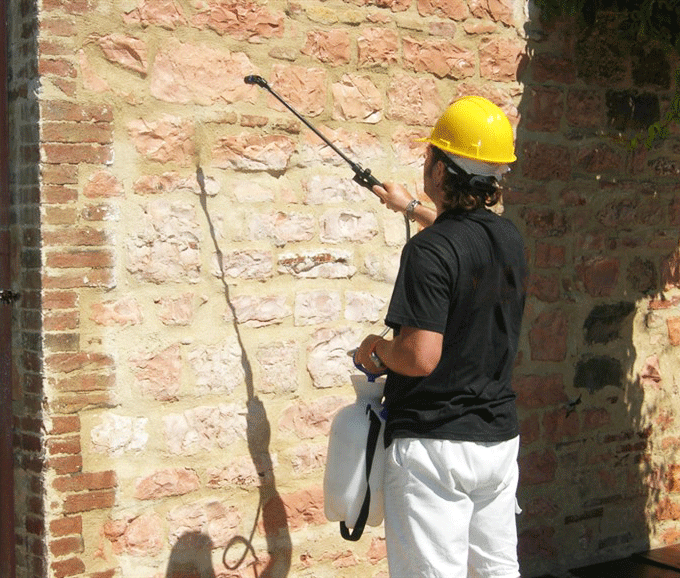 Facade surface cleaning
Facade surface cleaning
It is much more difficult to prepare wooden facades for the forthcoming work. Small chips are made on the boards that make up the wall. These actions are carried out so that the wood material does not warp later. After that, shingles are stuffed, which can be made from scraps of plywood or small planks. As a result, the entire structure should resemble a diagonal grid. Instead of shingles, you can use the facade decoration on the netting mesh.
Double layer wet or dry wall
The accessory simplifies the aesthetic detailing of the details. Maintenance and renovation - Light wet. Like all plasters, when heated, plaster can also grow in algae, mosses, etc. in adverse conditions. These organisms create clusters of greenish, irregular patches on facades.
Characteristics of types of facade plaster
Picture above: The first layer of honeycomb should be placed on a thick layer of mortar. The elements of porcelain stoneware are relatively large and the solution is deposited mainly in the horizontal welds. One layer requires a foundation. No matter how developed the house is, we must carefully protect it from winter. First of all, it means covering the unfinished and damp areas of the house from snow, rain and frost.
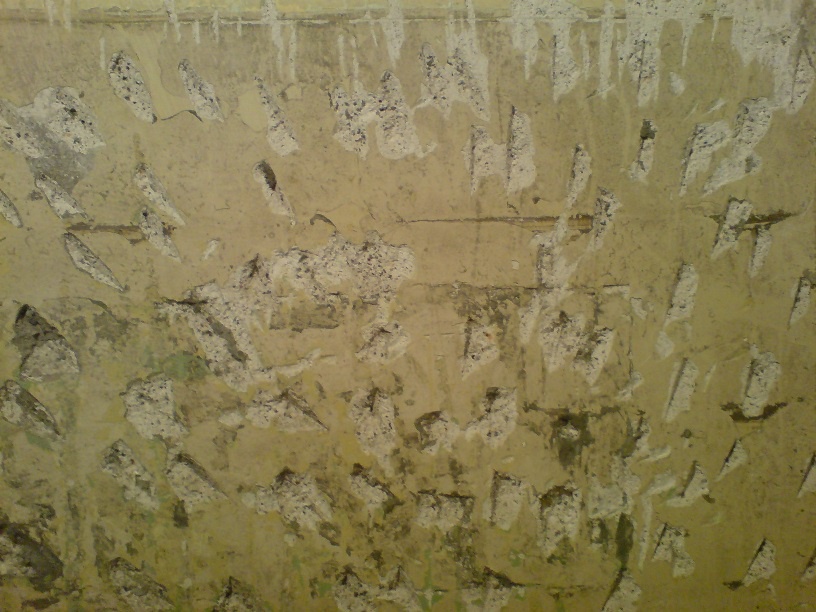 Punching notches on the wall surface
Punching notches on the wall surface Tools and materials
To create a ventilated façade, it is necessary to use a mixture of a binder with an aggregate and a certain amount of liquid. Great distribution received dry mixes of industrial production. To prepare a ready-made solution, it is enough to add the right amount liquids. The disadvantage of industrial mixtures is the high consumption of plaster, which will affect the final cost of the work.
Building a double house - pros and cons
To restore the elevation, it is necessary to consult with the co-owner in such conditions. Life sits sideways like a block. Segment walls must be carefully designed and fabricated to keep them in place. Forms, lichens, algae and mosses, on facades, terraces, in bathrooms. It can be used on almost any construction site, especially on mineral ones such as concrete, cement plasters, cement-lime plasters, cement screeds, joints.
Facade paints - for four seasons
The windows move in the spring, when the house has already been laid in the internal plaster, and employees are constantly working at the construction site. A window from a house left unattended for the winter is very easy to steal. Because they are organic and mineral. However, they cannot be applied to fresh renders because the substrates must be dry. Inorganic, i.e. mineral-cement, limestone and silicate, are used less often.
Cement-lime mortar is prepared from 1 hour of cement, 2 hours of lime mortar and 7 hours of sand. Cement plaster consists of 1 hour of cement and 3 hours of sand. The resulting composition is mixed until a homogeneous mass is obtained. Lime-clay mortar is prepared from 1 hour of clay, 4 hours of sand and 0.4 parts of lime. Gypsum plaster consists of 1 hour of gypsum, and 4 hours of lime-clay mass.
Mineral wool home warming
Always place from the top of the building to the bottom. It is ideal for plastering an entire wall in one day. There are different moisture conditions every day that can affect the color of the plaster.
Window replacement: from old to large and smaller
Make sure the mesh that is inserted into the mortar layer on the attached part is properly connected to the previously laid mesh. The mesh width is 10 cm and the new mesh does not apply to existing plaster. You need to grind it to the width of the plant, exposing the old mesh.Various elements are used for plastering:
- tools (plastering trowel, falcon, float);
- beacons;
- reinforcing mesh;
- dry mixes, primer;
- corners.
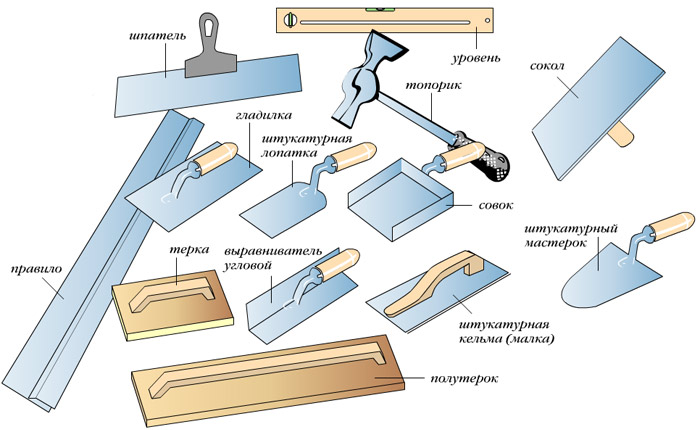 Instruments
Instruments
Without certain skills, it is quite difficult to achieve an even surface of the walls the first time, it is best to plaster the facade of the house along the lighthouses. These are small rails, thanks to which the mortar is smoothed vertically with a special rule. Not so long ago, guides were made from wooden blocks of the same section, from plaster or from mortar. Today, metal beacons can be purchased at any hardware store. But modern material has certain drawbacks, therefore, time-tested technology is more suitable for many craftsmen.
We buy adhesive mortar for facing tiles
Interior paints - white soothes
Aesthetic; Glossy paint will be more resistant to dirt and rain will clean it better. It is very important that when choosing facade paint pay attention to how it will affect the plaster, which will improve its properties, which may deteriorate. For example: silicone paint.Techniques for applying decorative plaster using rollers, matrices and stencils
The side walls should also be warmed up when they are not in contact with heated rooms. Sometimes only the tiles are covered with tiles and the rest are plastered. Slabs - instead of gypsum - are often double-walled walls. Facing tiles are easier to make and brighter than brick.
If you use metal beacons, then plastering go faster... However, after leveling the walls, the guides are removed, and the already plastered surfaces must be treated with mortar again.
The manufacture of lighthouses from a ready-made construction mixture is considered a rather laborious process, but after all the work is completed, there is no need to waste time on their extraction. Wooden guides are practically not used, because natural materials absorb moisture during operation and deform. Most often, lighthouses are used when decorating private houses from solid wood.
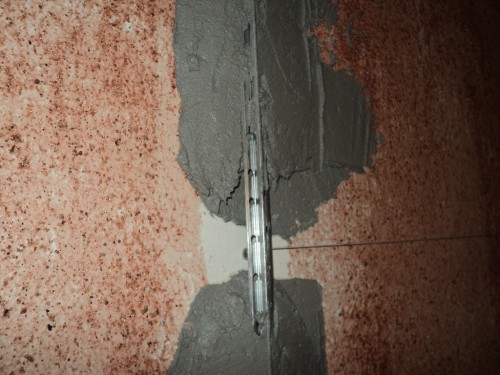 When installing beacons, you must use the level
When installing beacons, you must use the level 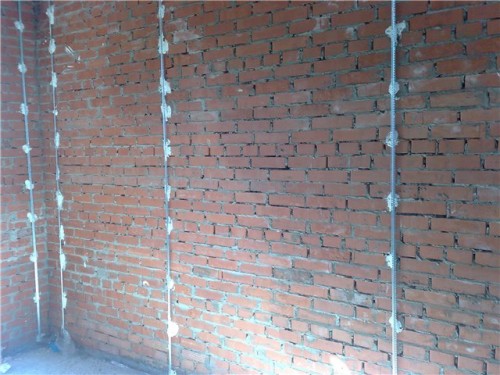 Beacons are installed over the entire surface of the facade
Beacons are installed over the entire surface of the facade Types of decorative plaster
There are several types decorative plaster... Silicate plaster is endowed with special strength, vapor permeability, durability. The composition includes potassium glass. Mineral plaster for facades it is resistant to mold. Consists of cement, absorbent materials. Acrylic mixture is the most flexible facade plaster. The main element of the solution is synthetic resin. Silicone plaster for the facade has many positive qualities and excellent composition, but at the same time its cost is much higher than that of similar materials.
By application method:
- pebble - warm plaster for the facade, after grouting, takes the form of small pebbles located very close to each other, sometimes the texture resembles a natural stone;
- mosaic plaster for the facade - the composition is particularly antistatic, hygroscopic. Transparent resin and fine mosaics in various shades allow you to create your original design facade;
- the most common cement plaster for facades has another name - bark beetle. A unique grooved texture is formed in the process of grouting a layer of mortar using a plastic flooring screed.
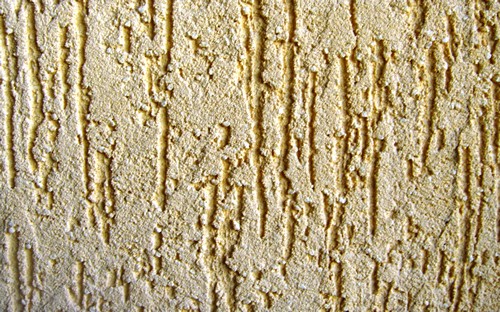 Bark beetle
Bark beetle 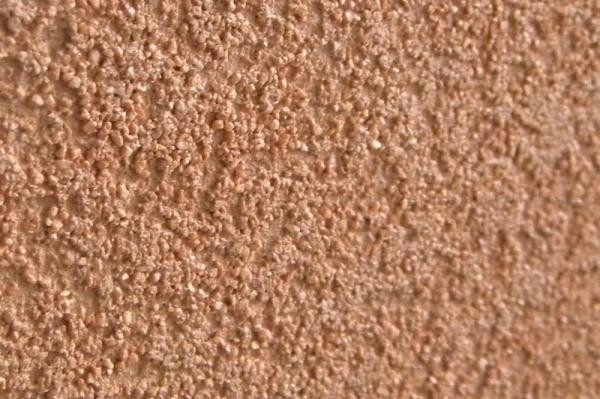 Kameshkovaya
Kameshkovaya 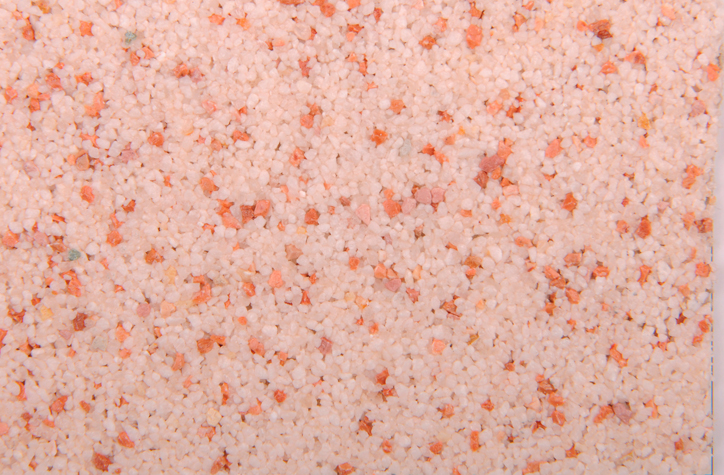 Mosaic
Mosaic In especially difficult climatic conditions, the insulated facade is finished decorative stone... Our photo selection contains the most popular ways decorative finishing residential building. Regardless of what the plaster consumption will be, the entire finish consists of several layers. In order to qualitatively plaster the base of the house, three layers of building mixture are applied to the surface of the wall: spray, primer and grout.
Surface spraying is the initial step finishing works... The main purpose of the spray is to provide a strong, durable adhesion to the plane of the subsequent plaster layer.
 Spraying clay plaster
Spraying clay plaster This requires a structural mortar with a thick batter. This consistency helps the mixture to fill the cracks formed, guaranteeing the strongest adhesion, allowing all subsequent layers in the plaster to be contained. For concrete or brick walls the thickness of the layer can be up to 0.5 cm, and 1 cm of the mortar is applied to the wooden covering.
The spray applied to the plaster facade on the insulation must be quickly smoothed out. Most often this occurs after the formation of large bulging or hanging streaks of solution on the vertical plane. After a few hours, the mortar dries out. After the final drying of the first layer, proceed to the next stage of construction work.
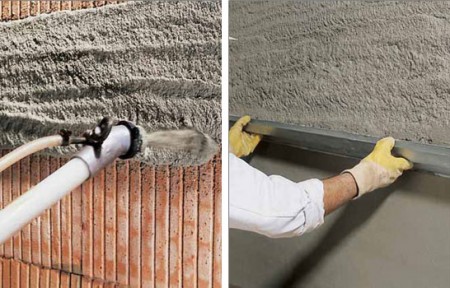 Machine plastering and leveling
Machine plastering and leveling Application of the base coat
In the second stage of plastering work, the main function of leveling out shallow cracks, chips, irregularities of the vertical surface is performed. Instead of a mortar, dry mixtures diluted to a sufficient density are used. The thickness of the soil can reach 2 cm. When throwing several layers of the mortar, the thickness of each subsequent layer should not exceed 1 cm. After the final application of the mortar, the vertical plane is leveled until a flat, smooth surface is obtained. In the process of work, you should use a falcon or half-grater, they may be directed in a different direction.
The more carefully each layer of the mortar is placed, the thinner the entire facade primer is.
All the elements that make up the priming solution are sieved through a coarse sieve, so rather large grains of sand can get into the mortar. In order to hide all cracks and roughness that have arisen during the priming process, a third period of finishing work is carried out.
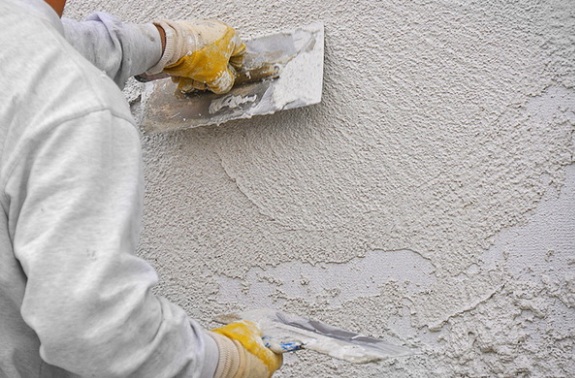 Application of the main layer of facade plaster
Application of the main layer of facade plaster Grout
Wet facade plastering is impossible without the final stage of finishing work, for this it is necessary to remove the cracks formed during the work, smooth out all the irregularities. The mortar for grouting has a similar consistency to the spray mortar. However, in terms of its quality characteristics, it significantly surpasses the previous mixtures. All components are pre-sieved through a fine sieve. The thickness of the coating solution is about 0.5 cm.
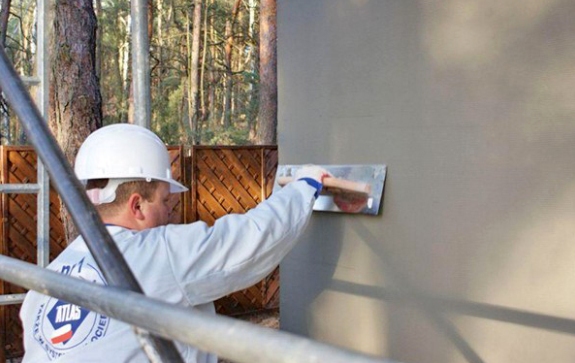 The process of smoothing the unevenness of the plaster mortar
The process of smoothing the unevenness of the plaster mortar The finishing layer is carefully leveled with a trowel or trowel, when the horizontal surface grabs, it is rubbed with a construction float. First of all, a circular grout is performed. To do this, with smooth counterclockwise movements, cut off the excess solution on the formed protrusions and rub it into the dents. The final step is to remove all circular marks from the plaster surface. Unaesthetic circles smooth out rectilinear movements construction float.
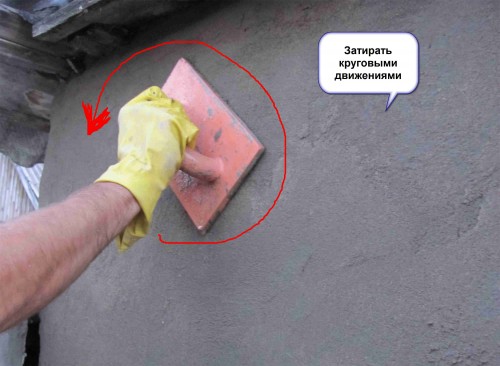 Grout should be done in a circular motion.
Grout should be done in a circular motion. Plastering the facade of a house takes a lot of time. To carry out the entire process in the shortest possible time, mechanized facade plastering is used. During work, specialists use a plastering station. High-tech equipment makes a batch and, under a certain pressure, applies the building mixture to a vertical or horizontal plane. The machine method can be used on all construction sites, the productivity is significantly increased, the consumption of the mixture is reduced. Despite all the seeming simplicity, the mechanical method of decorating the base of the house should be trusted by qualified specialists.
Video
The video tells how to properly plaster the facade of a building.
Photos of facades with applied decorative plaster
The selection of photos contains examples of facades decorated with decorative plaster.
